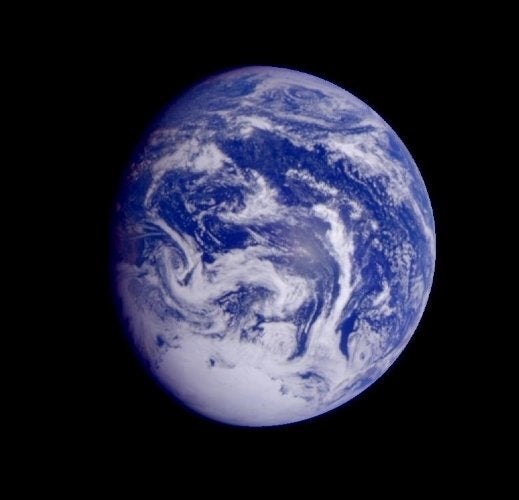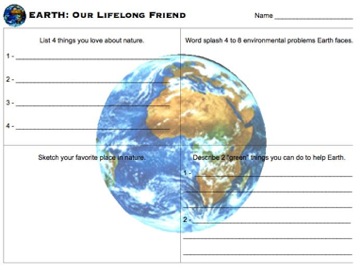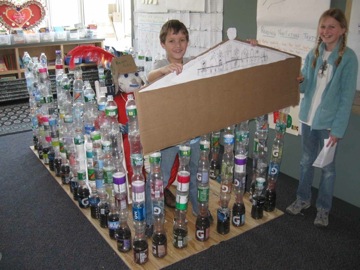
Sprinkle a few of the Earth Day seeds below into the fertile garden that is your classroom. With the help of your students, tend to these ideas, and watch them grow! Here are six activities that my fourth grade classroom at The Park School in Brookline, MA has been working on leading up to Earth Day. There are thousands of ideas out there, but I like these six. Perhaps one or two of them will fit into your 2nd to 8th grade classroom?
1. Warm-Up Worksheet: Get students thinking about the importance of a healthy Earth by reading two or three picture books about environmental sustainability, then having them fill out this sheet. It puts the ball in their court by asking them what they love about nature, what they know about environmental problems, and what they'd like to do to help. This can be done as a two-night homework assignment or in class. Download the worksheet here.

2. Recycling: Progressive teaching takes on the problems of the day by asking children to think creatively to solve them. Do this by discussing students' responses from the worksheet above and by trying to implement one or two of their ideas at your school.
Students will bring up recycling. Student-run recycling initiatives are popular in schools for a reason -- they're a perfect, age-appropriate topic to study that kids can do themselves and have real impact at school and at home. The fourth graders at my school collect over 800 pounds of paper waste each week. The third graders collect hundreds of bottles and cans. Marketing this work to the community can be especially creative. See this video for an example.
3. Build: After starting a recycling program, you will end up with large quantities of bottles, cans, paper, and cardboard. Before you have it collected by a recycling company, let your kids build with it! Challenge your students to build something that fits into your curriculum.
Could they build Egyptian pyramids? A scene from a text being studied in English class? How about a model of the Hudson River? A mosaic map of Colonial America made from bottle caps? As part of a social studies-centered curriculum, my fourth graders study Ancient Greece most of the year. We are currently building an 8'x4'x4' Parthenon out of bottles and cardboard recyclables while we study this famous temple and time period.
When ideas and learning become physical through hands-on building, kids have fun and concepts are more deeply understood and connected with. As teacher and author Tarry Lindquist says, "Making learning meaningful is the core of teaching. If children don't connect what's going on in the classroom with their minds, their hands, and their hearts, then it seems to me that not much learning is going to occur." Getting our kids' hands doing more than just wiggling pencils may be exactly what it takes to better engage their minds -- and if we're lucky, their hearts.
4. Cancel Sales Catalogs: My school started "The Catalog Canceling Challenge" in 2007, and since then other schools and scouts have joined the fun. So far 3,600 kids in eight states have canceled over 22,000 unwanted sales catalogs! It saves trees, water, energy, and our climate. In fact, these kids have saved over 290 trees so far! It's a pretty straightforward idea that kids really enjoy. If your school would like more information, go to www.CatalogCancelingChallenge.com. Or read our story here.
5. Take a Walk: Take your class outside. Visit some nearby woods to get inspiration for poetry or to sit and read books that are set in the woods. Kids spend so much more time indoors; many are never given the opportunities to connect with nature. Help facilitate this. It's easy if your school campus is rural, if not, visit a park. Many are surprised by how much ecology they can find in cities. When outdoors, kids can adopt trees, study insects or birds, help with landscaping, pick up litter, and other such activities. When the weather's warm, I try to move our "Read Aloud" time in a grassy patch not too far outside of the building. The kids love it -- unless the ground is wet.
6. Be a R.R.R.ole Model: It's important for us green-talkin' teachers is to be sure we're also doing the green walkin'. Model the 3 Rs: Reduce, Reuse, and Recycle. Great power lies in a teacher or an entire faculty that consistently uses reusable mugs and water bottles. Great power lies in a school that doesn't waste paper, has scrap bins by copy machines for reuse in classrooms, and doesn't allow cars to idle. The list goes on. Bike to work, start Green Committees, insulate walls and windows, turn off the lights, notice beauty in nature, read Robert Frost poetry, get outside. To teach green, we must live green and value our natural world, especially when our students are looking up to us. If we truly care about kids, we will take better care of Earth and teach them how to do the same.